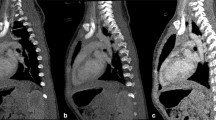Abstract
Parkes Weber syndrome is a rare disease characterized by overgrowth of an extremity linked to the presence of an arteriovenous malformation with multiple arteriovenous fistulas (AVFs). We report a patient with Parkes Weber syndrome with high-output cardiac failure due to multiple AVFs complicated by severe aortic regurgitation (AR) who required surgical treatment for AVFs. Division of the left deep femoral artery and banding of the left superficial femoral artery were performed. Such procedures can cause aggravation of AR and left ventricular failure due to the sudden increase in cardiac afterload. Pulmonary artery pressure, mixed venous oxygen saturation and cardiac index monitored by a thermodilution catheter, and a transesophageal echocardiography were useful in evaluating the effect of the surgical procedure and resultant acute increase in cardiac afterload on cardiac output and left ventricular function.


Similar content being viewed by others
References
Garzon MC, Huang JT, Enjolras O, Frieden IJ. Vascular malformations Part II: associated syndromes. J Am Acad Dermatol. 2007;56:541–64.
Berger TM, Caduff JH. Hemodynamic observations in a newborn with Parkes–Weber syndrome. J Pediatr. 1999;134:513.
Revencu N, Boon LM, Mulliken JB, Enjolras O, Cordisco MR, Burrow PE, et al. Parkes Weber syndrome, vein of Galen aneurysmal malformation, and other fast-flow vascular anomalies are caused by RASA1 mutations. Hum Mutat. 2008;29:959–65.
Neema PK, Ramakrishnan S, Sinha PK, Rathod RC. Anesthetic implication of surgical repair of an aortocaval fistula. J Cardiothorac Vasc Anesth. 2003;17:236–9.
Sharma ML, George KA, Gamble JAS. Anaesthetic implications of endovascular repair of aortocaval fistula. Anaesthesia. 2000;55:697.
Garcia FR, Gonzalez RS, Gonzalez EF, Cabrera de Paz R, Martin MR, Martin-Neda F, et al. Klippel Trenaunay–Weber syndrome: a long term study of a singular case. Pediatr Dermatol. 2004;21:397–8.
Radu C, Reich DL, Tamman R. Anesthetic considerations in a cardiac surgical patient with Osler–Weber–Rendu disease. J Cardiothorac Vasc Anesth. 1992;6:461–4.
Author information
Authors and Affiliations
Corresponding author
About this article
Cite this article
Ninagawa, J., Yamada, Y. General anesthesia in a patient with Parkes Weber syndrome with high-output cardiac failure due to multiple arteriovenous fistulas complicated by severe aortic regurgitation. J Anesth 24, 256–259 (2010). https://doi.org/10.1007/s00540-010-0875-8
Received:
Accepted:
Published:
Issue Date:
DOI: https://doi.org/10.1007/s00540-010-0875-8




